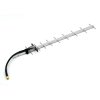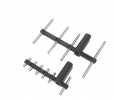I have the SG906 Pro and if you look closely at the RC "antennae" you'll see that there's no wires going to them...they're just dummies. The Yagi's won't work.
They probably don't work very well, but just because you don't understand HOW they work doesn't mean they are "dummies" and don't work at all. They couple to the existing drone antennas and shape the RF pattern after that. They don't need a wire or cable to do that, but a cable connection would be a lot more effective.
A Yagi antenna might have a dozen elements, but only one of them is normally dirven with transmitted energy. The rest of the elements receive energy from the driven element and change the phase by virtue of the elements in front being shorter and the one in back being longer, and then re-radiate that energy with the phase difference creating the shaped pattern. In the case of clip on Yagis, the driven element is still the original one in the drone and the clip on elements do the receiving/phase shift/re-radiating/pattern shaping. The energy coupling just isn't as effective.












